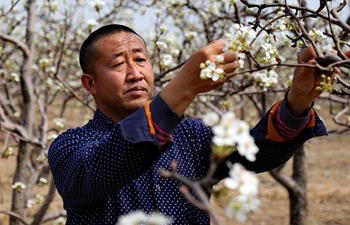WASHINGTON, April 3 (Xinhua) -- Scientists on Monday revealed technical details behind the world's first baby who was born one year ago using a new and controversial three-parent method, offering families with inheritable mitochondrial disorders the chance to have healthy children in the future.
The procedure known as mitochondrial replacement therapy (MRT), which was detailed in the journal Reproductive BioMedicine Online (RBMO), resulted in the birth of a healthy baby boy to a carrier of Leigh Syndrome, a progressive, fatal neurological disorder caused by a mutation in the mother's mitochondrial DNA.
At the time the paper was written, the baby was seven months old and healthy, lead author John Zhang of the New Hope Fertility Center in New York said.
However, Zhang told Xinhua he was unable to know the boy's latest health status since the baby's parents, a Jordanian couple, can't come to the United States due to a travel ban enacted by President Donald Trump.
The mother of the boy had four pregnancy losses and two deceased children due to Leigh Syndrome before she and her husband sought Zhang's help in 2011.
The severity of the disease is associated with the percentage of affected mitochondria, or the mutation load.
The mother is asymptomatic as her mutation load is only 24.5 percent, less than half the expected 60 percent threshold load for the disease. Her son, born on 6 April 2016 after in vitro fertilization IVF with MRT, had a mutation load ranging from 2.36 to 9.23 percent, depending on the tissues tested, well below the expected threshold for the condition.
It is currently unknown whether the mutation load will remain the same throughout his life.
The researchers used an electrofusion technique to transfer the nuclear genome from the mother's egg, while leaving behind most of the mother's mitochondria, to the cytoplasm of a donor egg containing only healthy mitochondria.
This egg was then fertilized by the father's sperm and transferred to the mother's womb and a baby boy was born at 37 weeks after an uneventful pregnancy.
Two methods of cell fusion have been used in the past by various groups researching MRT. Most groups have utilized a virus to accomplish cell fusion, however, the extent of viral DNA carryover is unknown. The other method involves a metered electrical pulse to initiate cell fusion.
Comparably, electrofusion is a more demanding technically, but has no risk of viral DNA carryover, the researchers said.
The ovarian stimulation and egg collection procedures, mitochondrial replacement and fertilization were carried out by Zhang's team in New York. The frozen embryo was then transferred to an affiliated fertility clinic in Mexico, where it was implanted in the patient's womb.
"For some years, reproductive specialists have been able to deselect genetically affected embryos with mitochondrial disease, using sophisticated diagnostic procedures in the IVF laboratory," Professor Bart Fauser, Editor-in-Chief of RBMO, said in a statement.
"Now, for the first time, an egg with abnormal mitochondria can be changed to contain mostly normal mitochondria from a healthy egg donor. This is a major change of technology and an obvious advantage for women who are at risk of passing such diseases on to the next generation."
The announcement of the birth of the first baby born using MRT, first reported by the New Scientist magazine in 2016, was met with mixed reactions in the media -- acknowledging the enormous scientific achievement but raising ethical concerns surrounding travel to Mexico to bypass federal regulations in the Unitd States.
"Aside from the issues that have been raised about avoiding U.S. regulations by treatment in Mexico, and questions of adequacy of their consent procedures, this is an excellent proof of principle that MRT can be applied to ameliorate the transmission serious mitochondrial DNA disease in a very deserving family which has been plagued with many members dying of Leigh Syndrome," Peter Braude, emeritus professor of obstetrics and gynaecology at King's College London, said.
However, Professor Robin Lovell-Badge from London-based Francis Crick Institute, was more cautious.
"It is of course good news that the woman being treated was able to have an apparently healthy child with no signs of mitochondrial disease, but from the paper it seems that in many respects Zhang and colleagues were sailing very close to the wind and that luck played a large part in the outcome," Lovell-Badge said.
It's worth to note that whilst this is still an experimental technique in its infancy, a fertility clinic in Newcastle has been granted in March the first licence in Britain to carry out the controversial MRT treatment.


















